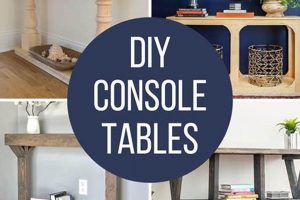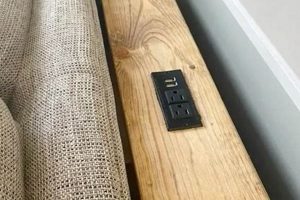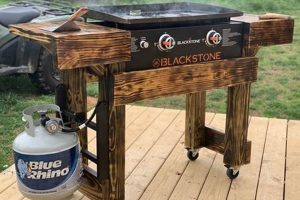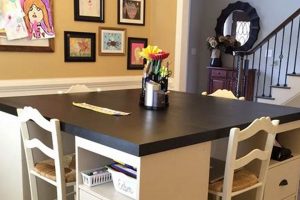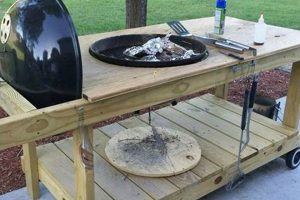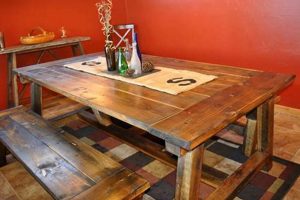The construction of a low-lying surface designed for placement in a seating area, utilizing reclaimed wooden platforms and employing do-it-yourself methods, presents an accessible furnishing project. This undertaking repurposes readily available shipping components into a functional furniture piece, offering a cost-effective alternative to traditional retail options. The process involves disassembling, cleaning, and reassembling the wooden structure to achieve the desired tabletop dimensions and aesthetic.
The appeal of such a project stems from several factors. It provides an avenue for creative expression through customization of finishes, leg styles, and incorporated features. Furthermore, it aligns with environmentally conscious practices by diverting waste materials from landfills and promoting resourcefulness. Historically, the practice of repurposing discarded materials for furniture construction reflects a broader trend of sustainable living and resource optimization driven by economic constraints and environmental awareness.
The following sections will delve into specific considerations for undertaking such a project, including material selection, structural reinforcement, finishing techniques, and design considerations. These topics provide a framework for successfully transforming reclaimed shipping components into a functional and aesthetically pleasing centerpiece for living spaces.
Guidance for Pallet-Based Low Table Construction
The subsequent recommendations are designed to enhance the durability, safety, and aesthetic appeal of a low surface constructed from reclaimed wooden platforms. Adherence to these guidelines will contribute to a more satisfactory outcome.
Tip 1: Material Assessment. Prior to commencing construction, thoroughly inspect the wooden platform for structural integrity. Avoid platforms exhibiting significant rot, pest infestation, or chemical contamination. Heat-treated platforms, denoted by an “HT” stamp, are generally considered safer than those treated with methyl bromide (MB).
Tip 2: Secure Fastening. Utilize appropriate fasteners to ensure a robust and stable structure. Wood screws of sufficient length and gauge are recommended over nails, as they provide greater holding power. Consider pre-drilling pilot holes to prevent wood splitting, especially when working with hardwoods.
Tip 3: Surface Preparation. Proper surface preparation is essential for achieving a professional finish. Sanding the wooden surface smooths imperfections and creates a suitable substrate for paint, stain, or sealant. Start with a coarse grit sandpaper and progressively transition to finer grits for optimal results.
Tip 4: Sealing and Protection. Apply a suitable sealant or finish to protect the wooden surface from moisture, stains, and wear. Options include polyurethane, varnish, lacquer, and penetrating oils. Choose a product appropriate for the intended use and environmental conditions.
Tip 5: Leg Attachment. Selecting and attaching appropriate legs is crucial for stability and aesthetic appeal. Consider factors such as height, style, and weight-bearing capacity. Metal or wooden legs can be attached using screws, bolts, or specialized mounting hardware. Ensure proper alignment and secure fastening to prevent wobbling.
Tip 6: Edge Treatment. Address the edges of the wooden platform to enhance safety and visual appeal. Sharp edges can be rounded over using a router or sanding block. Edge banding or decorative trim can also be applied to create a more refined appearance.
These considerations represent critical elements in the successful creation of a functional and visually pleasing furnishing. Prioritizing these steps ensures longevity and usability of the completed project.
The concluding section will summarize key safety precautions and provide resources for further exploration.
1. Pallet Source
The origin of the wooden platform significantly influences the feasibility, safety, and overall outcome of the repurposed low-surface construction. Careful evaluation of platform provenance is a fundamental prerequisite for any such project.
- Treatment Type
Shipping platforms undergo various treatments to prevent pest infestation and decay. Methyl Bromide fumigation, indicated by the “MB” stamp, poses significant health risks and renders the platform unsuitable for indoor furniture construction. Heat treatment, identified by the “HT” stamp, represents a safer alternative as it relies solely on thermal processing. Untreated platforms present their own risks, potentially harboring pests or pathogens. Verifying the treatment method is, therefore, paramount.
- Usage History
The previous contents transported on the platform are a critical consideration. Platforms used to transport chemicals, hazardous materials, or food products may retain residues that are difficult to remove and could pose health concerns. Identifying the platforms prior cargo and assessing the potential for contamination is essential for ensuring the safety of the finished furnishing. Visible staining or unusual odors can indicate potential contamination.
- Structural Condition
The physical integrity of the platform directly impacts the structural stability and longevity of the constructed surface. Platforms exhibiting significant damage, such as cracks, splits, or missing components, may compromise the structural integrity of the final product. A thorough inspection for structural defects is crucial to ensure the safety and stability of the repurposed furnishing. Utilizing only structurally sound platforms minimizes the risk of collapse or failure.
- Supplier Reliability
Obtaining platforms from reputable sources can provide greater assurance regarding treatment methods and usage history. Suppliers specializing in reclaimed materials often implement screening processes to identify and discard unsuitable platforms. Establishing a relationship with a reliable supplier can mitigate risks associated with platform sourcing and enhance the overall quality of the repurposed furniture project. Direct procurement from shipping or manufacturing facilities may also offer insights into platform history.
The interplay of these factors underscores the importance of diligent platform assessment prior to commencing the repurposing process. Neglecting to consider the platform’s treatment, history, condition, and origin can result in compromised structural integrity, potential health hazards, and an unsatisfactory finished product. Prioritizing responsible platform sourcing is, therefore, an indispensable element in successful furnishing construction.
2. Wood Treatment
The treatment applied to wooden platforms prior to their repurposing into low surfaces directly impacts the safety, durability, and aesthetic possibilities of the final furnishing. Understanding these treatments is paramount for responsible and effective construction.
- Fumigation Methods
Shipping platforms are often fumigated to prevent the spread of pests and diseases. Methyl bromide (MB) was a common fumigant, but its toxicity necessitates careful avoidance. Platforms marked with “MB” should not be used for indoor furniture. Heat treatment (HT), an alternative, poses significantly less risk. The presence or absence of fumigation, and the type used, dictates the safety precautions required.
- Preservative Application
Wood preservatives, such as chromated copper arsenate (CCA), can extend the lifespan of wooden platforms, particularly those exposed to moisture. However, CCA contains arsenic, a known carcinogen. While the risk from casual contact is low, sanding or cutting CCA-treated wood releases dust containing arsenic, which poses an inhalation hazard. Identification of preservative treatments is crucial for implementing appropriate safety measures, such as wearing respirators during sanding or avoiding the use of such platforms altogether.
- Sealing and Coating
Surface treatments, including sealants, paints, and varnishes, are applied to protect the wood and enhance its appearance. The type of coating dictates its suitability for a low surface. Oil-based paints may emit volatile organic compounds (VOCs), while water-based finishes offer a lower-VOC alternative. The durability of the coating affects the long-term maintenance requirements of the constructed furnishing. Prior knowledge of the coating composition informs the choice of appropriate cleaning products and refinishing techniques.
- Natural Weathering
Exposure to the elements, such as sunlight and rain, can alter the characteristics of the wood. Weathering can result in discoloration, surface cracking, and the leaching of natural oils. Understanding the extent of weathering informs the necessary surface preparation steps, such as sanding or bleaching, required to achieve the desired aesthetic. Weathered wood may also be more susceptible to moisture damage, necessitating the application of a protective sealant.
Therefore, assessment of wood treatments applied to shipping platforms is essential for determining the safety and preparation requirements associated with their repurposing into a low surface. The choices made regarding platform selection and treatment management directly influence the final product’s safety, longevity, and aesthetic appeal.
3. Design Choices
The aesthetic and functional attributes of a low surface constructed from reclaimed shipping components are fundamentally determined by design decisions made throughout the construction process. These choices encompass a spectrum of considerations, ranging from overall dimensions to the selection of finishing materials, and directly impact the utility and visual appeal of the finished piece.
- Dimensional Configuration
The size and proportions of the low surface influence its suitability for a given space and its capacity to accommodate various items. A larger surface area provides ample space for serving refreshments or displaying decorative objects, while a smaller footprint is more appropriate for compact living areas. Height is another critical factor, affecting both the ergonomic comfort of users and the visual balance of the room. The selection of dimensions should reflect the intended purpose of the furnishing and the constraints of the surrounding environment.
- Structural Modification
The extent to which the original shipping platform is altered impacts both the aesthetic character and the structural integrity of the finished surface. Retaining the platform’s original form preserves its rustic aesthetic, while extensive modifications allow for greater design flexibility. However, altering the platform’s structure can compromise its load-bearing capacity, necessitating reinforcement measures. Design decisions regarding structural modification must balance aesthetic preferences with engineering considerations.
- Surface Treatment Application
The selection of surface treatments, such as paints, stains, and sealants, significantly influences the visual appeal and protective qualities of the finished surface. Opaque paints conceal the underlying wood grain, offering a uniform color and texture. Stains, conversely, enhance the natural grain patterns while adding color. Sealants protect the wood from moisture, scratches, and stains. The selection of surface treatments should reflect the desired aesthetic and the anticipated use of the furnishing.
- Hardware Integration
The incorporation of hardware elements, such as legs, casters, or decorative embellishments, can enhance both the functionality and the visual interest of the low surface. Legs elevate the surface to a comfortable height, while casters facilitate mobility. Decorative embellishments, such as metal accents or carved details, add visual flair. The selection of hardware should complement the overall design aesthetic and contribute to the functionality of the finished piece. Care must be taken to ensure secure and stable attachment of any hardware.
Collectively, these design decisions shape the final form and function of the low surface. A thoughtful approach to these choices ensures that the finished piece is both aesthetically pleasing and well-suited for its intended purpose. Disregarding these choices leads to a product that is unappealing and without purpose.
4. Structural Integrity
The successful repurposing of reclaimed wooden platforms into low surfaces hinges upon the structural integrity of the constituent materials and the construction methods employed. A compromised structure risks instability, collapse, and potential injury, thereby negating the cost-effectiveness and sustainability benefits associated with this furnishing approach.
- Material Assessment and Selection
The initial step in ensuring structural integrity involves a rigorous assessment of the wooden platform’s condition. Platforms exhibiting rot, significant cracking, or signs of pest infestation are unsuitable. The type of wood used in the platform’s construction also affects its strength; hardwoods generally provide greater load-bearing capacity than softwoods. Careful selection of platforms based on material quality and condition is paramount.
- Joint Reinforcement Techniques
The points at which individual wooden components are joined represent critical stress points in the assembled structure. Reinforcement techniques, such as the use of metal fasteners (screws, bolts) in conjunction with adhesives, are essential for enhancing joint strength. The proper application of these techniques prevents loosening or separation of components under load. Inadequate joint reinforcement can lead to instability and eventual failure of the low surface.
- Load Distribution Considerations
The design of the low surface must account for the anticipated load distribution. Even weight distribution minimizes stress on individual components, while concentrated loads can create weak points. Strengthening measures, such as the addition of internal supports or bracing, may be necessary to accommodate anticipated load patterns. Failure to consider load distribution can result in localized deformation or catastrophic collapse.
- Stability Augmentation Methods
The overall stability of the constructed low surface is influenced by factors such as its footprint, height, and the attachment of legs or supports. A wider base provides greater stability, reducing the risk of tipping. Secure and rigid attachment of legs is essential for preventing wobbling or instability. Augmenting stability through design modifications and hardware selection enhances the safety and usability of the finished furnishing.
These interrelated facets of structural integrity underscore the importance of a comprehensive and informed approach to constructing low surfaces from reclaimed wooden platforms. Prioritizing structural integrity through careful material selection, robust joint reinforcement, thoughtful load distribution planning, and effective stability augmentation ensures a safe, durable, and aesthetically pleasing furnishing outcome.
5. Surface Finishing
The process of surface finishing is inextricably linked to the successful execution of constructing a low surface from reclaimed wooden platforms. This crucial step directly influences the aesthetic appeal, durability, and overall safety of the completed furnishing. Without proper surface preparation and protective coatings, the repurposed wooden platform remains vulnerable to moisture damage, abrasion, staining, and the potential splintering of wood fibers, rendering it unsuitable for practical use as a low surface. A poorly executed finish detracts from the inherent character of the wood and shortens the lifespan of the furnishing.
Surface finishing encompasses a range of techniques, each with its own implications for the final product. Sanding removes imperfections and prepares the surface for subsequent coatings. Staining enhances the natural grain of the wood, while painting provides a uniform color and protective layer. Sealants, such as polyurethane or varnish, create a durable, water-resistant barrier that protects the wood from spills and scratches. The choice of finish depends on the desired aesthetic, the intended use of the surface, and the level of protection required. For instance, a surface intended for heavy use, such as one regularly exposed to beverages, requires a more robust sealant than a surface primarily used for decorative purposes. A rustic design may benefit from a matte sealant, showcasing the wood’s natural texture, while a more modern aesthetic may call for a glossy finish. Improper surface preparation or the selection of an inappropriate finish can lead to adhesion problems, uneven coloring, or premature wear.
In summary, surface finishing constitutes an indispensable component in the construction of a low surface from reclaimed wooden platforms. It directly impacts the aesthetic appeal, functional longevity, and overall safety of the furnishing. Careful consideration of surface preparation techniques, coating selection, and application methods is essential for achieving a durable, visually pleasing, and practically useful piece of furniture. Neglecting this aspect significantly diminishes the value and usability of the finished product.
6. Leg Selection
The selection of legs for a low surface constructed from reclaimed wooden platforms directly influences the furniture’s stability, aesthetic appeal, and functional height. The weight-bearing capacity of the legs must be adequate to support the platform and any items placed upon it. Inadequate support leads to instability and potential structural failure. Leg height determines the surface’s ergonomic appropriateness for its intended use. For instance, a surface intended for use while seated on a sofa requires a different leg height than one intended for use with floor cushions. The leg stylewhether straight, tapered, hairpin, or custom-designedcontributes significantly to the overall aesthetic, complementing or contrasting with the rustic character of the reclaimed wooden platform. The chosen attachment method, such as screws, bolts, or specialized hardware, must ensure a secure and durable connection between the legs and the platform.
Examples of leg selection impacting the final product abound. Hairpin legs offer a mid-century modern aesthetic and are suitable for lighter loads. Straight wooden legs provide a more traditional appearance and can be customized in length and finish. Metal legs offer enhanced durability and a contemporary industrial aesthetic. Casters, or wheeled legs, provide mobility but may compromise stability on uneven surfaces. The material of the legswood, metal, or plasticmust be compatible with the platform’s construction and the intended environment. Wood legs may require sealing or painting to prevent moisture damage, while metal legs may require powder coating to prevent rust. Correct installation is critical; improperly attached legs can cause the surface to wobble or collapse.
In conclusion, the process of selecting legs when repurposing wooden platforms into low surfaces demands careful consideration of weight-bearing capacity, height, style, and attachment methods. The stability, aesthetics, and functionality of the finished piece are directly contingent upon these choices. Challenges may arise in sourcing legs that are both aesthetically pleasing and structurally sound, especially when working with unusually sized or shaped platforms. Nevertheless, a well-informed leg selection process is fundamental to achieving a successful and enduring furnishing outcome, seamlessly merging sustainability with practical design.
7. Safety Measures
The creation of low surfaces from reclaimed wooden platforms, commonly undertaken as a do-it-yourself project, necessitates strict adherence to safety measures due to inherent risks associated with material sourcing, tool usage, and potential structural instability. Neglecting safety protocols can result in physical injuries, exposure to hazardous substances, and compromised structural integrity of the finished product. For instance, the improper handling of power tools during cutting or sanding operations can lead to lacerations or eye injuries. A lack of awareness regarding potential chemical contaminants present in the wood can lead to skin irritation or respiratory problems. Therefore, the integration of safety measures is not merely an ancillary consideration but a fundamental component of the entire construction process.
Specific examples of safety measures include wearing appropriate personal protective equipment (PPE), such as safety glasses, gloves, and respirators, when handling potentially hazardous materials or operating power tools. Thorough inspection of the wooden platform for signs of structural weakness, pest infestation, or chemical contamination is crucial. Safe tool handling practices, including proper training and adherence to manufacturer’s instructions, are essential to prevent accidents. Adequate ventilation is necessary to minimize exposure to dust and fumes generated during sanding and finishing operations. Furthermore, ensuring the structural stability of the finished surface through reinforcement techniques and load testing mitigates the risk of collapse and potential injury. Real-world examples demonstrate that failure to implement these measures has resulted in injuries ranging from minor cuts and abrasions to more serious incidents involving power tool accidents and structural failures.
In conclusion, the successful and safe construction of low surfaces from reclaimed wooden platforms hinges on the conscientious implementation of comprehensive safety measures. These measures address potential hazards associated with material sourcing, tool usage, and structural integrity. Understanding and adhering to these precautions minimizes the risk of injury, exposure to hazardous substances, and structural failures. Therefore, safety measures are not optional but are an integral element of any such furnishing project, ensuring both the well-being of the constructor and the long-term usability and safety of the finished product.
Frequently Asked Questions
This section addresses common inquiries and misconceptions surrounding the creation of low surfaces utilizing reclaimed wooden platforms, providing objective and factual responses.
Question 1: What are the primary safety considerations when undertaking such a project?
Safety considerations include: wearing appropriate personal protective equipment (PPE) such as gloves, safety glasses, and respirators; ensuring adequate ventilation to mitigate dust and fume inhalation; thoroughly inspecting reclaimed wooden platforms for structural integrity, pest infestation, and signs of chemical contamination; and adhering to safe tool handling practices as outlined by the manufacturer.
Question 2: How does the source of the platform impact the suitability for repurposing?
The platform’s origin dictates potential contamination risks. Platforms used to transport chemicals, hazardous materials, or food products may retain residues, rendering them unsuitable for use as furniture. Platforms treated with Methyl Bromide (MB) pose significant health risks and should be avoided. Heat-treated platforms (HT) are generally considered safer.
Question 3: What are the key indicators of a structurally sound platform?
Key indicators include: absence of significant cracks, splits, rot, or warping in the wooden components; secure and intact joints between the components; and a general lack of evidence suggesting past overloading or damage. Compromised platforms should not be used.
Question 4: What type of finish is recommended for a low surface constructed from reclaimed platforms?
The recommended finish depends on the intended use and desired aesthetic. Polyurethane and varnish offer durable, water-resistant protection. Oil-based finishes provide a richer color but may emit volatile organic compounds (VOCs). Water-based finishes offer lower VOC emissions. Prior to applying any finish, thorough surface preparation, including sanding, is essential for optimal adhesion and appearance.
Question 5: How can the stability of the finished low surface be ensured?
Stability is ensured through: selecting sturdy and properly sized legs; securely attaching the legs to the platform using appropriate hardware (screws, bolts); ensuring the legs are evenly spaced and aligned; and considering the overall dimensions of the surface, opting for a wider base for greater stability. Reinforcement of joints may also be necessary.
Question 6: Are there any legal or regulatory considerations regarding the use of reclaimed platforms?
Legal and regulatory considerations are generally minimal for personal, non-commercial use. However, commercial production and sale of furniture constructed from reclaimed platforms may be subject to regulations regarding material safety, labeling, and waste management. It is advisable to consult with local authorities or legal professionals for clarification on applicable regulations.
In summary, a judicious approach to material selection, construction techniques, safety measures, and finishing processes is paramount for achieving a successful and enduring low surface from reclaimed wooden platforms.
The subsequent section will summarize key takeaways and provide additional resources for further exploration.
Conclusion
The preceding sections have explored the diverse facets of constructing a low surface from reclaimed wooden platforms, commonly termed “coffee table pallet diy”. Key aspects include material sourcing and assessment, structural reinforcement, design considerations, surface finishing, leg selection, and stringent adherence to safety protocols. Successfully navigating these elements directly correlates with the durability, functionality, and aesthetic value of the finished furnishing.
Responsible application of the principles outlined herein transforms discarded shipping components into functional household items, demonstrating a commitment to resourcefulness and environmental stewardship. Continued adherence to best practices in material selection, safety, and structural integrity remains paramount for realizing the full potential of “coffee table pallet diy” and ensuring the longevity and safe utilization of these repurposed furnishings. Further research and refinement of techniques within this construction method will undoubtedly yield advancements in both its practicality and aesthetic appeal.


